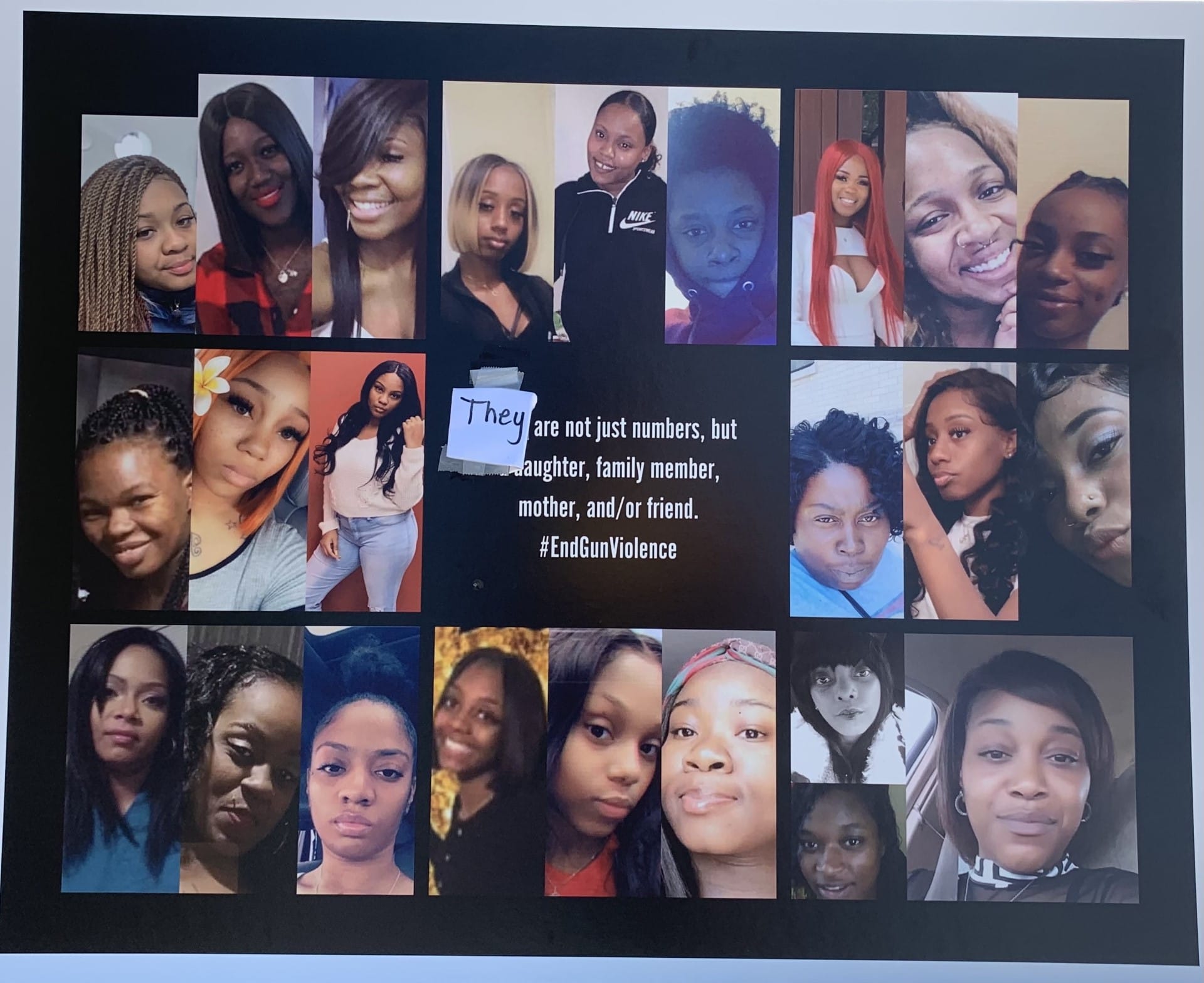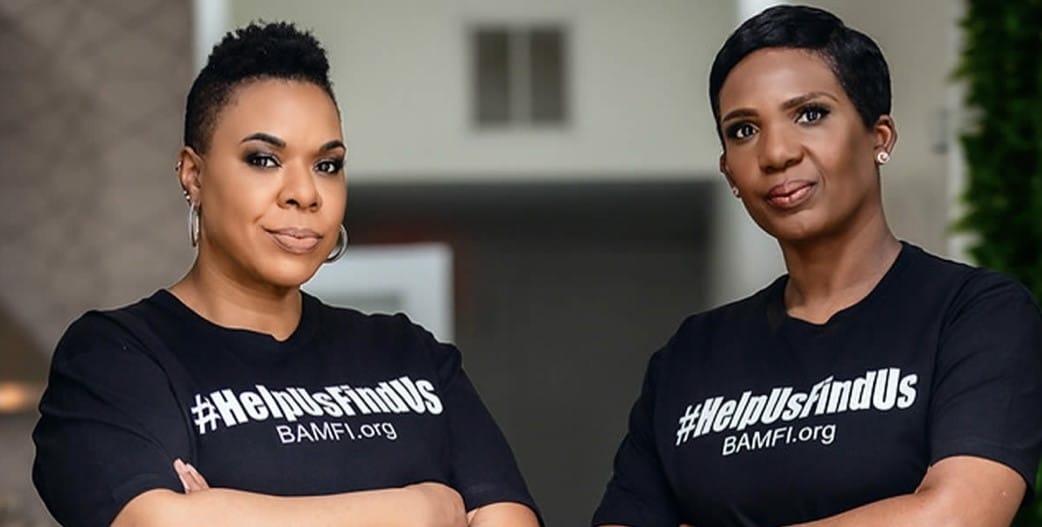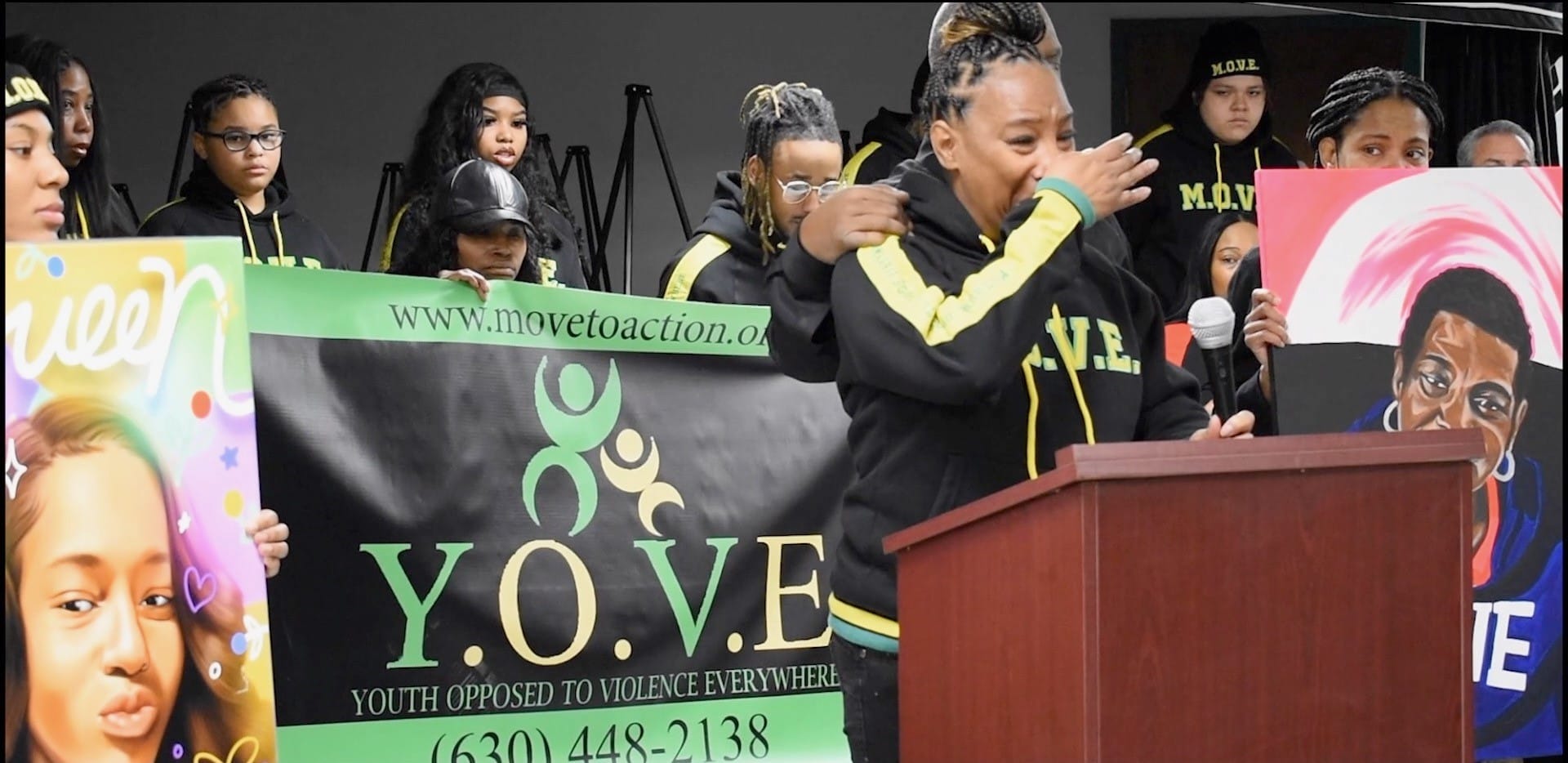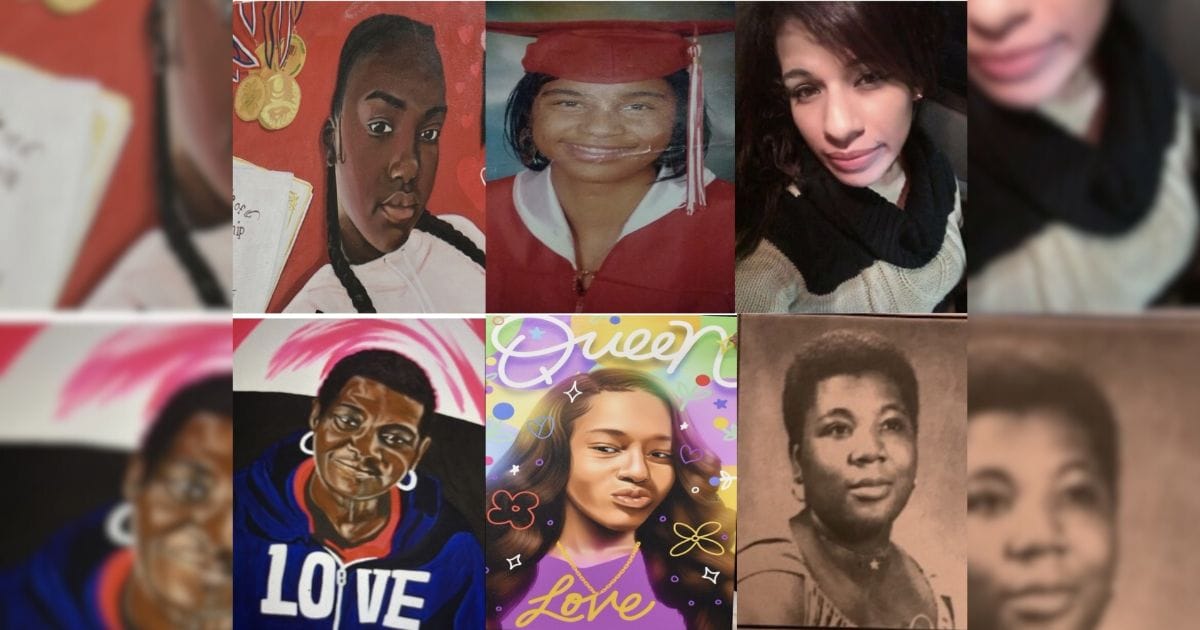Pictured is a photo collage of women and girls killed in Chicago and Indiana. (From left to right: Kentayvia Blackful, Shantieya Smith (graduation photo), Jessica Flores, Daisy Hayes, Shantieya Smith (portrait) and Linda Green)
Natalie Wilson, co-founder of the Black and Missing Foundation, remembers like it was yesterday: flipping through newspapers, watching national headlines tick across the television screen over Lori Hacking, 27, a white woman, reported missing in Salt Lake City in 2004. Months earlier, Tamika Huston, 24, a Black woman, was reported missing from Spartanburg, South Carolina. But within weeks in Huston’s case, there was only silence. No new developments being reported. No breaking news. No follow-up. No non-stop stories set on 24-hour repeat. No palpable sense of urgency or salient interest by the news media about the case of a missing young Black woman.
In fact, Wilson, 54, soon no longer saw or heard Huston’s name in the news media. And her disappearance, began to fade into the shadows behind that other name dominating the media spotlight: Lori Hacking, the missing woman who was white. For Wilson, it was not an unfamiliar phenomenon but standard practice by the mainstream American press. As clear as black and white. Wilson and observers and advocates contend it is a fact of this American life that the cases of Black and brown women and girls who go missing, or murdered, aren’t looped on cycles of 24-hour national broadcast news stations. Rarely featured on front pages of newspapers, or even displayed on billboards. Their names, and faces—Black and brown—simply too often are forgotten, though some analysts question whether it is a sin of omission or commission. “Oftentimes, when our children are reported missing, they’re classified as runaways,” Wilson says. “If you’re classified as a runaway, you do not receive the Amber Alert. You definitely don’t get any type of media coverage at all.” The narrative of missing and murdered women of color in the United States is perhaps as compelling as it is also deeply disturbing in scope and in the details that emerge from a collective portrait of both data and also the innumerable anecdotes of victims as well as their families.
Collectively, thousands of Black and brown women are murdered or go missing each year, according to researchers, analysts, and women advocacy groups who contend that the color of a female victim’s skin matters in many ways in America. Not least among them is in the lack of media attention that many observers and critics say the cases of Black and other women of color receive compared to the cases of white women. Such disparity, they contend, is also evident in the not easily quantifiable number of those cases—both the missing and the murdered— that each year go unsolved by police and that amount to a rising sea of carnage that one media report has labeled, in part, “an unspoken epidemic.”

This much is clear and calculable: That from 2019 through 2021 alone, 5,240 Black women and girls were killed with the 2,078 homicides recorded in 2021 representing a nearly 54 percent increase since 2019, according to the Centers for Disease Control and Prevention (CDC). That the homicides of Black women and girls outpaced the number of homicides overall nationwide, which rose comparatively by 36 percent during that same time period, the latest CDC figures show. That Black women experience nearly three times the homicide rate of white women, according to a 2017 CDC study. That, according to another analysis, even as homicides among all persons in the U.S. rose 30 percent in 2020, the rate for Black females exceeded that number, spiking 33 percent, despite accounting for roughly only 7.3 percent of the U.S. population.
That missing females and males of color in 2021, according to the National Crime Information Center, account for 38 percent of a total 521,000 missing persons cases. Of that figure, 34 percent are Black, despite Blacks comprising only 13.6 percent of the population. And of that 34 percent, 89,020, or at least 50 percent, were Black females, 88,477 were Black males, and there were missing Black persons for whom gender was unknown.
Still, exactly how many people go missing each year is difficult to measure, say some researchers and analysts, explaining that there is no single source or clearinghouse for those numbers and that many cases likely go unreported. In fact, the National Crime Information Center’s figures, referred to as the “NCIC’s Missing Person File,” was implemented in 1975. Those records, according to the agency, “are retained indefinitely, until the individual is located, or the record is canceled by the entering agency.”
The National Crime Center’s statistics are cited by the Hyattsville, Maryland-based Black and Missing Foundation whose nationwide effort seeks to bring attention to the issue of missing and murdered Black people and hardcore evidence of the disparity.
The numbers are staggering, and the clear disproportionate number of missing and murdered persons of color is alarming.
The Guardian, in an investigative series in 2022 on Black women and girls that included its own analysis of data from the Atlanta-based Centers for Disease Control and Prevention, determined that in 2020 the death rate for Black women rivaled the death rate for Black men. Moreover, The Guardian analysis, based on FBI data, found that in 2020, five Black women and girls were killed every day in the United States.
Labeling it, “an unspoken epidemic,” that has been “unfolding over the years,” The Guardian, a London based newspaper, saw cause to examine this particular issue in the U.S. It found that even as homicides of all persons in the U.S. rose 30 percent in 2020, the rate for Black women spiked 33 percent. The report further contended that “Black women and girls in the US are four times more likely to die by violence than white or Hispanic women,” and that in 2020 alone, 1,821 Black women and girls were killed.
“The national homicide rate for Black women and girls in 2020 was eight homicides per 100,000 people. That’s the highest rate among American women and represents a risk of violent death that is four times higher than white or Latina women,” the Guardian reported, adding that indigenous women and girls, at 5.8 homicides per 100,000, are the next highest at risk.
Among the states named in The Guardian’s analysis as having among the highest homicide rates for Black women and girls was Washington, Missouri and Kentucky in the top three, with the District of Columbia at fifth, followed by Indiana at sixth, and Illinois at tenth.
The murder of Black women and girls increased across all age groups—from children to senior citizens—The Guardian reports, and research shows. They were largely gunshot victims at the hands of a current or former intimate male partner.
In fact, firearms were used in 53.9 percent of female homicides, although at a higher rate in the homicides of Black women, at 57.7 percent, according to a 2017 Centers for Disease Control and Prevention study. That report also found that non-Hispanic Black and American Indian/Alaska Native women experienced the highest rates of homicide at 4.4 and 4.3 per 100,000 population respectively, and Hispanic women at 1.8 per 100,000, compared to all other races that each had a homicide rate of less than 2 per 100,000.
Behind the numbers are the flesh and blood, heart and soul, and painful stories of victims and their families. The agony of some families is exacerbated by the belief that the color of their loved one’s skin makes their cases less palatable for main stream news media, less likely to be solved by law enforcement, and far less likely to eventually receive “justice.”
For many families, there is no word for days, weeks, months, years, if ever, about the whereabouts of missing loved ones. No call from police that they have found a suspect in cases of murder.
The case made by researchers, analysts and families is a compelling one, and the anecdotes emanating from the numbers too compelling and too plenteous to ignore. It is a story they believe must be told. For the good of those stolen, for the good of America, for the greater good of us all.
Sounding the Alarm
Founded in 2008, the Black and Missing Foundation’s purpose is to raise awareness to missing persons of color by providing resources and tools to missing persons’ families, friends and communities. In their advocacy and activism through the Black and Missing Foundation, co-founders, Derrica and Natalie Wilson, sisters-in-law, have for years now, taken parents of missing children by the hand, and guided them in pursuit of finding them.

The organization was hatched after the two women, both African American, noticed a stark difference in how the case of Tamika Huston was being covered by mainstream American news media, Natalie Wilson recalls. As time progressed, Huston’s case got lost in the shuffle while the cases of white women beamed from the television screen on national newscasts.
“Weeks after Tamika disappeared, Lori Hacking vanished, and she dominated the news cycle. Just about every national outlet covered her story,” says Natalie Wilson. “The same thing a year later in 2005, Natalee Holloway disappeared,” she added, referring to the case of the 18-year-old woman from Mountain Brook, Alabama, who disappeared May 30, 2005, while vacationing in Aruba.
The sisters-in-law had a front-row seat to observe media bias in America, they contend, watching the Huston family desperately fight for media attention.
“Tamika’s aunt reached out to those same outlets, same reporters, same networks, and was met with silence, and it was very heartbreaking for that family,” Wilson recalls.
Witnessing an anguished Black family beg for coverage and parity from news outlets motivated the two women to take action.
“We decided, ‘why not us? Let’s do something about it,’” Natalie Wilson says. “I’m in public relations, and awareness and exposure on these missing individuals is key, and Derrica is in law enforcement.”
Led to conduct their own research, they sought to lend credence to the apparent disparities in how homicides and missing person cases of people of color are treated by law enforcement and also to identify disparities in the news media’s treatment of those cases. Disturbed and also inspired by their findings, they began their work to try and raise the profile of such cases through advocacy on their own.
“The perception is that when a Black or brown person goes missing no one is going to miss them except their families. I wanted to help our missing become household names too,” says Natalie Wilson.

The two women remain on the frontlines of advocacy, helping families, case by case, in a hands-on approach that includes offering strategies and consulting. They are among other activists, advocates and researchers nationwide working to bring the issue of missing and murdered, particularly Black women and other women of color, to greater public light, if not to also sound the alarm.
In Minnesota earlier this year, the House of Representatives passed a bill establishing an office for missing and murdered Black women and girls. The office, currently under development, will be tasked with reviewing cold cases for missing Black women and girls, as well as reviews of death investigations in which such cases had been ruled a suicide or overdose of suspicious circumstances.
Amid criticisms of Chicago-area families and community activists that a clogged system of DNA testing hampers police murder investigations, the Illinois State Police since 2020 says it has significantly diminished its DNA processing backlog. The improvement in turnaround time, officials said, was achieved through robotics, Rapid DNA, and the addition of more forensic scientists at the Illinois Forensic Science Lab. Still, the availability of DNA results doesn’t necessarily translate into solving more cases of the murdered or the missing.
In California, the state legislature is currently considering creating an “Ebony Alert” notification system “to address the often ignored or lack of attention given to Black children and young Black women that are missing in California,” according to a statement from democratic state senator Steven Bradford who introduced SB 673.
“When someone who is missing is incorrectly listed as a runaway, they basically vanish a second time. They vanish from the police detectives’ workload,” Bradford’s statement continues. “They vanish from the headlines. In many ways, no one even knows they are missing. How can we find someone and bring them home safely when no one is really looking for them.”
Judged By the Color of Their Skin
Dr. Cheryl L. Neely, 57, professor of sociology at Oakland Community College, remembers growing up in Detroit, riding the Grand River bus with her two sisters and childhood friend Michelle Kimberly Jackson. Their time together as little girls who grew from prepubescent innocence, carefree chatter and friendship in the Motor City, into young women with promising futures, would be cut short one winter’s day.
On a cold Tuesday, on January 24, 1984, Michelle, 16, was murdered and raped while on her way to school. Years and a lifetime away, Neely, who was 18 at the time, still remembers feeling consumed by anger because no one, at the time, seemed to care.
“My outrage on a personal level was that when my friend was murdered there was not the level of media coverage and police attention that I believed her case deserved,” she says.
How Jackson’s case was handled was the catalyst for Neely’s work. In 2015, she published, “You’re Dead – So What?: Media, Police, and the Invisibility of Black Women as Victims of Homicide.” The book examines media bias in reporting homicides of Black women, and law enforcement’s alleged failure to thoroughly investigate the deaths of Black women. Neely says that her most significant research finding is that in a society, where Black women’s lives don’t matter, their deaths don’t either, and that there is clear evidence of bias in the news media’s coverage of the stories of murdered or missing Black women.
“I could predict that certain elements of the story would be present, based on the victim. What I found was that if the story of the victim’s death was going to be on the front page of the paper, the victim would be white,” Neely says in an interview. “If there were multiple stories about the victim, the victim would be white.”
“If there was a photograph of the victim, which would humanize her to the reader, the victim would be white,” Neely adds. “I could predict that if this was present, the victim would be white.”
In her book, Neely contrasts police treatment of the death of Black women and white women that occurred in the same city around the same time. She found that when Black victims were missing, police did not display in their initial response, or in their investigative efforts, the same level of urgency compared to cases where the victim was white. The family of Black victims, in most cases, were frustrated, and begging police to treat their cases with a greater sense of urgency, she writes. More often than not, however, they received push back or inaction from police.
“When a white victim went missing, there were police on it right away,” Neely says.
According to advocates and experts like Wilson and Neely, at the core of media bias and any lack of urgency by police in such cases are stereotypes rooted in racism.
“We need to change the narrative that missing Black and brown individuals are involved in some sort of criminal activity,” Natalie Wilson contends.
When Black women are suspected to be involved in sex work, they don’t receive sympathy or urgency from the news media or police, analysts say. Neely adds that even if police investigators determine in cases where a female victim is white and has a history of involvement with sex work and/ or drug abuse—neither of these two elements was a leading factor in the investigation. Nor did it negatively impact the case or police efforts.
Moreover, Neely contends that the cases of missing and murdered white females involved in sex work are still handled by news media with humanity and compassion, while Black women with similar backgrounds too often are treated like suspects in their own deaths, or at least as having contributed to their demise by so-called hazardous lifestyles.
“When they cover their [white women’s] stories, they would almost apologize or explain away the substance abuse or sex work by saying, ‘She wanted to get her life together, or she was on the verge of recovery,’” says Neely. “They explained it in a humanizing way, which they rarely, if ever, did with a Black victim.”
Unforgotten
In 2020, journalism students at Roosevelt University sought to humanize the case of 51 mostly Black women murdered in Chicago from 2001 to 2018 and deemed by the Alexandria, Virginia-based Murder Accountability Project to be serial murders. The Roosevelt University students’ reporting project revealed that the majority of women had been labeled by law enforcement as prostitutes or else, to some degree, having been involved in sex work and illicit drug use. Many families of victims, however, refuted that contention.
Charles Green, 58, whose sister Linda Green, was murdered— her body found in a Chicago South Side alley on May 20. 2003—believes that race is the reason his sister’s case has lacked news media coverage and remains unsolved 20 years later.
“Do you think if these were 51 white women this would’ve happened? This would’ve been all on CNN and everywhere,” Green says.
Not everyone, however, agrees that race is the “elephant in the room” regarding the apparent disparity in how the news media or the police treat the cases of missing and murdered Black women.
Thomas Hargrove, 67, founder of the Murder Accountability Project, which tracks unsolved homicides nationwide, says that based on a computer algorithm at least one serial killer is behind the Chicago case. Hargrove also says he believes Chicago police are working diligently to solve those cases—something Chicago police also have continually publicly asserted.
“I don’t believe the police don’t care,” Hargrove says. “Chicago Police have been taking a hard look at these cases to see what they can find.”
He added that the common thread of missing DNA in the Chicago cases is not only unusual but may be part of the difficulty in solving them.
“Although these were strangulations of women who often were sex workers and drug addicts, there was astonishing little DNA recovered from the crime scene,” says Hargrove. “Only a third had DNA, which is very unusual. The Chicago Police supervisors also aren’t sure why.”
Twenty-two years since the first reported murder among the 51, nearly all of the cases remain unsolved. The rare mention in the city’s two major daily newspapers or on nightly news stations is as invisible as a cold Chicago wind.
Meanwhile, the families of victims seek solace, a reason to hope, and justice.
‘Unanswered Questions and A Broken Heart’
In February, Rev. Robin Hood and Mothers Opposed to Violence Everywhere, sought to raise awareness about missing and murdered women of color at Greater Rock Missionary Baptist Church on Chicago’s West Side, where the families of victims shared tears and testimonials amid stories of their unsolved cases.
LaTonya Moore, stood at the podium, telling the crowd of several dozen about her daughter, Shantieya Smith, 26. She recalled that inside the Cook County morgue years earlier, while standing over her daughter’s lifeless caramel-brown body it was clear that only one of her daughter’s 22 tattoos had been left unscathed by her killer. It is a memory etched into a mother’s soul: a single tattoo on her daughter’s decomposed arm.

Smith was reported missing on May 26, 2018. She was found weeks later in a garage near 18th Street and Central Park Avenue in the city’s North Lawndale neighborhood. Five years since her murder, police have made no arrests. There is no news of new developments or leads, Smith says. And for a grieving mother, there are only unanswered questions and a broken heart.

“Where is the DNA? The DNA vanished in 2020, it’s 2023,” Moore, in tears, shouted to the crowd. “As I was talking to the detectives, it was like a run-around. At first, they had a handprint on a garage. Then they went from that to, ‘We never got any evidence, and the case is closed.’”
The cases of 51 mostly Black women remain unsolved without any charges except for one: Diamond Turner, found strangled and beaten, her body dumped in a trash bin on Chicago’s South Side, in the Grand Crossing neighborhood. She was discovered by a trash collector in March 2017. Arthur Hilliard, a Chicago man, has been charged in her murder and a suspect in two other murders but none of the other women in the 51.
Prior to the work by Roosevelt University journalism students in 2020, there was little coverage in the mainstream press that Black women might be being targeted in Chicago by a potential serial killer. And there has been little-to-no buzz in the local news media about the case since then.
Still, Hargrove insists that the lack of coverage in the Chicago case, or in the cases of murdered and missing Black women nationwide has anything to do with race.
“I can’t speak for the media. And is that factually true?” he responds when asked during an interview whether there is a correlation.
“As to why there appears to be a difference in how missing persons are treated? I’d have to say we do a horrible job in tracking people in the United States regardless of race,” Hargrove continues. “I don’t know if that’s racist. It certainly is a problem.”
Others see it differently.
For Natalie Wilson, little has changed since she watched Lori Hacking become a household name while Tamika Huston’s disappearance soon dissolved into silence. Since then, Natalie Wilson has witnessed the number of missing Black women and girls—of Black people—steadily rise. Like scattered balloons— released by loved ones across America in their memory—that drift into blue skies and vanish in the air.
But should their names and stories be forgotten by all except their families and loved ones, they also will at least be remembered by two women who continue to sound the clarion call.
“These are our mothers, fathers, our grandparents, our children, nieces, nephews, sisters, brothers, and our neighbors who are disappearing at an alarming rate,” says Natalie Wilson. “We need to continue to sound the alarm.”
Next: A skull, human vertebrae, a suspect, and one family’s wait for justice
Samantha Latson holds a master’s degree in journalism from Indiana University and earned a bachelor’s at Roosevelt University. A three-time winner of the National Association of Black Journalists’ “Salute To Excellence Award, she was a reporter and editor on her undergraduate capstone project, “Unforgotten 51,” which garnered wide acclaim. In July 2023, she won second place in the National Society of Newspaper Columnists for Social Justice commentary for her work on the project, “Invasion of Faith,” about one church’s fight to save the soul of a violent city. She is completing a reporter-internship on the Metro desk at The Washington Post as a Ben Bradlee Fellow and worked as an Ida B. Wells fellow at the Post in summer 2022 on its investigative team as an intern.






